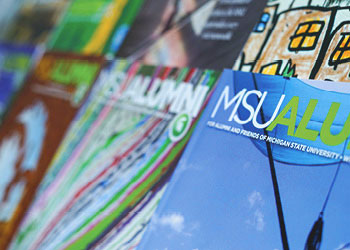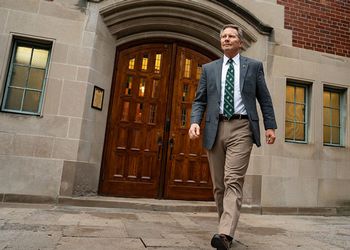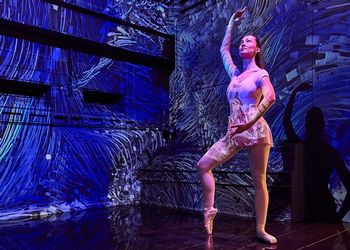Feature: Underground Railroad

New Book Explores MSU Football's Role in Civil Rights Movement
As MSU closes its year-long 60/50 Project—marking the 60th anniversary of the Supreme Court decision in Brown vs. Topeka Board of Education and the 50th anniversary of the signing into law of the Civil Rights Act—MSU alumnus and sportswriter Tom Shanahan, ‘’78, explores the university’s trailblazing role in the integration of college football.
His new book, Raye of Light: Jimmy Raye, Duffy Daugherty, the integration of college football and the 1965-66 Michigan State Spartans,was released this fall. Below is an excerpt from chapter one.
Summer turned to fall in September 1963 as Michigan State University’s freshman football recruits arrived to a postcard scene with 5,000 acres of rolling green grass, towering trees and the Red Cedar River running through campus. The varsity players already were practicing for their Sept. 28 opener at Spartan Stadium when the freshmen gathered for the first time.
MSU football coach Duffy Daugherty loaded his 1963 football recruiting class aboard what came to be called the Underground Railroad. They included black athletes from the segregated South who were denied a chance to attend their home-state university simply for skin color, and they featured no fewer than three future College Football Hall of Famers—Bubba Smith of Beaumont, Texas; George Webster of Anderson, South Carolina; and Gene Washington of La Porte, Texas.
The College Football Hall of Famer combined his southern recruits with his northern prospects to form his grandest haul in 19 years as the Spartans’ head coach. In all, the class produced four two-time All-American players who were also first-round picks in the 1967 National Football League draft: Smith, Webster, Washington and Clinton Jones of Cleveland, Ohio. Smith was selected No. 1 overall by the Baltimore Colts; Jones No. 2 to the Minnesota Vikings; Webster No. 5 to the Houston Oilers; and Washington No. 8 to the Minnesota Vikings. No school has come close to matching four picks among the top eight.
A year after the 1963 recruiting class, the Underground Railroad delivered a pioneer black quarterback from segregated Fayetteville, North Carolina. Jimmy Raye proved to be ahead of his time—decades ahead. In his junior season in 1966, he was Michigan State’s first black starting quarterback and the first black quarterback from the South to win a national title.
The Underground Railroad is a football story, but it is also a drama of heartless racism that forced players to look North for an opportunity, and of decent-hearted people who helped them reach Michigan State to play Big Ten football and earn a college degree.
Raye led Daugherty’s national powerhouse in an era when the quarterback position, the most important in football and perhaps the most difficult to play in sports, was reserved for white players in the North as well as the South. He was one of 11 black starters in 1966—an unheard-of number for the time—with four on offense and seven on defense.
Raye followed his playing days, including two years in the NFL as a defensive back, with a coaching career of 40-plus years in the college and NFL ranks. He was often the only black coach on the staff early in his career at both levels and as a result has been an active voice in minority hiring as president of the NFL Coaches Association. Add up his playing and coaching careers, and he is the most socially significant player among the Underground Railroad recruits.
Although Raye was not one of Michigan State’s five All-American players—he was second-team All-Big Ten to Purdue University All-American Bob Griese—the coaches realized he was indispensable to their offense and national championship shortly before the 1966 season opener. A practice squad player ran into Raye as he held the ball for an extra-point kick, sending him to the university infirmary with knee and lower leg injuries on the Saturday before facing North Carolina State. Michigan State quarterbacks coach Al Dorow revealed the code-red level of concern when he spoke a month after the season to a Jimmy Raye Day audience in Fayetteville. They fretted their season was going up in smoke.
“Well, we thought we’d had it,” Dorow said. “Not another solid quarterback on the squad, and Jimmy on crutches. Tuesday before the game, he was still hobbling around. The next day, though, he couldn’t stand seeing another guy at his position and decided to give it a whirl.
“It was painful, but he stayed with it. But that’s the difference in good ball players and great ball players. The great ones never miss a game, and from that day on, we knew we had winner in Jimmy Raye.”
Raye directed four touchdown drives for a 28-3 lead before N.C. State scored a late touchdown in Michigan State’s 28-10 victory at Spartan Stadium. MSU was fortunate Raye started all 10 games in that historic 1966 season, including playing through the Ohio State and Purdue victories with a bruised shoulder that he suffered in a win over Michigan.
A loss early in the year without Raye and there would have been no showdown with Notre Dame in “The Game of the Century.” With no national title chase to create headlines and draw a record television audience, the legacy of the game’s first fully integrated roster from the 1965 and 1966 Underground Railroad seasons would have been diminished.
The significance of Michigan State’s success became more than a sports story. African-Americans and any American favoring Civil Rights causes joined forces with Spartans fans. The Underground Railroad recruits of the 1960s did not confront the surreptitious, dangerous journey American hero Harriett Tubman led when she guided escaped slaves to freedom a century earlier on the genuine Underground Railroad. They did not participate in protests. But Civil Rights leader Rev. Jesse Jackson said it was important to the cause simply for them to be seen in stadiums, newspapers, magazines and on television in America’s living rooms: “These athletes redefined race relations in many ways. Why do we do so well in baseball, football, basketball and track? On the ball field the playing field is even. When the rules are objective and public, and the referees are fair, we can win. The ball field is so unique. These athletes made it to the top because fair rules lend themselves to achieving.”
In 1966, Raye was one of only two black quarterbacks who were starters at a major conference school. The other was Stanford University’s Gene Washington, though Washington was switched to receiver for his junior and senior years. Two starting black quarterbacks—like two black head coaches in the future—was enough progress to prompt Ebony magazine to devote a story in its December 1966 issue to the football exploits and campus life of Raye and Washington.
Raye led Michigan State’s 1966 march to the de facto national championship showdown with Notre Dame. The Game of the Century was the Bowl Championship Series before there was a BCS. The debate for identifying the top two teams in America was reduced to whether No. 1 Notre Dame and No. 2 Michigan State was the correct order.
Football came of age when The Game of the Century was played on November 19, drawing the sport’s largest television audience at that time with 33 million viewers and a staggering 22.5 Nielsen rating. The nation saw Raye and the rest of the Spartans, to borrow a line from the TV marketing of the era, in living color.
The monumental game ended in a then-controversial and now immortal 10-10 tie. The custom at the time saw multiple organizations name their choice as national champion. The most recognized were the Associated Press and United Press International polls that voted Notre Dame No. 1 and Michigan State No. 2 despite both schools finishing with 9-0-1 records, and these AP and UPI tallies are still debated to this day. Two other recognized major national titles were the Football Writers Association of America (FWAA) and the National Football Foundation (NFF). The FWAA agreed with AP and UPI, but the NFF departed course and named Michigan State and Notre Dame national co-champions. The NFF presented its MacArthur Bowl Trophy to the Michigan State and Notre Dame head coaches and team captains on December 6 at the Waldorf-Astoria in New York City (the NFF still awards the MacArthur Bowl Trophy but instead of picking a champion, the trophy has been presented to the winner of the BCS title game).
Michigan State’s national title allowed Raye to follow in the footsteps of his inspiration, the University of Minnesota’s Sandy Stephens of Uniontown, Pennsylvania. In 1960, Stephens was the first black starting quarterback to lead a team to a national title and the first black quarterback named an All-American pick.
Another 19 years would pass before a black quarterback matched Stephens and Raye as the starter on a national championship team. Oklahoma University’s Jamelle Holloway directed the Sooners’ wishbone offense to the national title in 1985.
Raye’s 1966 and 1967 seasons as a starter and his Rose Bowl performance in relief as a sophomore backup in 1965 defied the stereotype that black athletes could not play a “whites-only” position that required intelligence and leadership. He possessed both qualities in abundance and continued to earn the respect he gained in his coaching career. By 1983, Raye was one of the first NFL black offensive coordinators, serving on the Los Angeles Rams’ staff under head coach John Robinson.
The genesis of the Underground Railroad that opened Raye’s career path was Duffy Daugherty’s selection as the 1955 American Football Coaches Association Coach of the Year, the same season the Spartans won the 1956 New Year’s Day Rose Bowl. Daugherty was a national figure who was on the cover of Time magazine’s October 8, 1956, issue. The 1950s was an era that Time publisher Henry Luce dubbed “The American Century,” and he considered a Time cover the most coveted honor in American culture.



